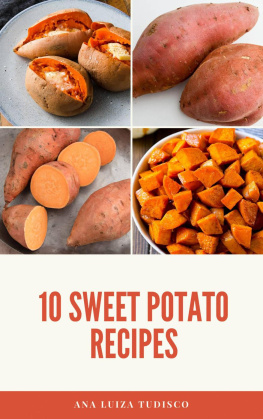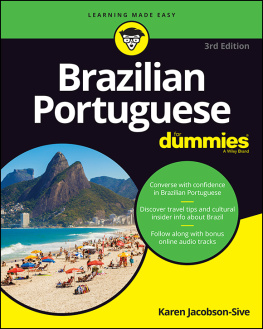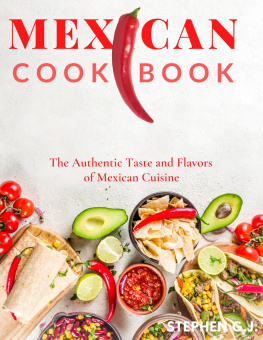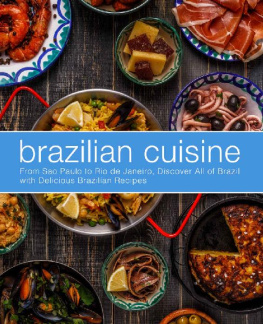PREFACE
CUISINE ON PAPER
Carlos Alberto Dria, Sociologist
T his is Ana Luiza Trajanos 4th book. In it, she widens her travels researching roots Brazilian cuisine, as she sees it, to also devote herself to everyday home cooking. The first-person narrative refers to the universe that spawned the collected recipes. The authors taste is particularly highlighted by family life, her guide through countless recipes that come from the Brazilian domestic and urban tradition. The reader could chalk it up as another book of recipes following the tradition of the old
Comer Bem Dona Benta, which have been available since the 1940s. It wouldnt be terribly original had it not been for the authors particular vision on this list commonly found recipes.
Thus, what grants the book its originality is the authors point of view, now added to the collection of works known as cookbooks. This expression encompasses every written material about the art of cooking or/and relative to the different existing cuisines and cooking styles. An universe that includes various types of books: the old and the new, available in libraries and bookstores; the binders and notebooks filled with recipes that are found in homes, convents, hotels, castles, hospitals, institutions such as factories, businesses, schools, childrens homes, and prisons; and, also, books relating to food critique. We should also consider that cookbooks have been fundamental in stablishing a Western gastronomy. This means that the creation of a specific field that shaped and mediated culinary preferences greatly relied on the emergence of these publications. Although this type of cooking is closely linked to real life cooking (which is practiced daily in each and every society), cookbooks do not set out to reproduce it, purely and simply.
In registering, recording, and publishing it in various platforms, cookbooks end up transforming what is real into a taste paradigm and, eventually, into a mark of the identity of a whole people as it happens, for instance, in France, where a culture of writing about the art of cooking generate style of cuisine that is emblematic in the West. In Brazil, the influence of French gastronomy began in the 19th century and is reinforced by the arrival of famed French chefs like Claude Troisgros and Laurent Suaudeau, among others, after the 70s. These chefs began to appreciate and make use of Brazilian ingredients, either native or acclimated, such as the jabuticaba, pitanga, mango, jackfruit, manioc flour, and mandioquinha, among many more, giving rise to what is currently defined as Brazilian Cuisine, which is practiced by local professionals that constantly revisit and reinterpret the traditional aspects of Brazilian cooking. Due to Trajanos efforts, this mark is also present as she approaches tradition with a modern gaze, holding on to the things that she believes to be worthy, seeking to project them into time. And so, many ingredients that were virtually forgotten such as the prosaic lambari reemerge; some backwards steps are taken in this search for a higher quality, such as the recipe for pudim de leite that doesnt make use of condensed milk. Making these recipes available was the purpose of Dona Benta.
Time went by and gastronomy developed along multiple directions until we lost sight of its domestic roots. Trajanos books seeks to bring us back to that place, while updating it. Its original in the fact that it no longer addresses the outdated homemaker, a character that became undone in the last few decades. It wishes to dialog with those who practice home cooking, regardless of their gender, and who are not supposed to toil over the stove day in and day out. Nowadays, the majority of the middle class doesnt eat at home. Its only natural that, when cooking at home, we seek pleasure and not only nourishment.
If this book reaches this one goal, it will have fulfilled its worthy cause and these are our wishes for it. ABAR

12 units

40 minutes, plus time for hydrating

Difficult 3 TEACUPS BLACK-EYED PEAS, PEELED 3 LARGE ONIONS TEACUP DRIED SHRIMPS, PEELED TEACUP DEND OIL SALT TO TASTE 6 BANANA LEAVES, FOR WRAPPING Allow the peas to soak in cold water for at least 12 hours. Drain the peas and blend them in a food processor with the onion, dried shrimp, dend, and salt, until obtaining a smooth paste. Cut the banana leaves in half and pass them through the stove's low flame, to make them more flexible. Hold out the leaf with your hand and, right at the center, arrange three spoonfuls of abar batter. Close carefully, making sure all the batter is wrapped, and steam for 5 minutes.
When it is firm, remove the leaf and serve with vatap, dried shrimp, . IN DETAIL Along with the first slaves, in the 16th century, arrived the custom of wrapping pasty foods in banana leaves, common in countries such as Nigeria and Dahomey - present day Benin. The abar, an yoruba term, is an example of this sort of wrapped delicacy, which only was made possible in Brazil thanks to the dend oil. Differently from its "cousin", the acaraj, it is cooked in steam (and not fried). ACARAJ

12 units

1 hour, plus time for soaking

Medium 3 TEACUPS BLACK-EYED PEAS, PEELED 4 LARGE ONIONS 1 CUP DRIED SHRIMP, OR TO TASTE SALT AND BLACK PEPPER TO TASTE DEND OIL, FOR FRYING
GREEN TOMATO VINAIGRETTE 6 PEELED, DESEEDED GREEN TOMATOES, CHOPPED ONION, CHOPPED CUP EXTRA VIRGIN OLIVE OIL 2 TABLESPOONS APPLE VINEGAR OR LIME JUICE BUNCH CORIANDER LEAVES, CHOPPED BUNCH CORIANDER STEMS, CHOPPED SALT AND BLACK PEPPER TO TASTE Allow the peas to soak in cold water for at least 12 hours. Drain them and blend them in a food processor with the onions and salt, until obtaining a smooth batter.
Drain it with a sieve, removing the excess liquid. Meanwhile, prepare the vinaigrette: mix the tomatos, onion, olive oil and vinegar. Season with salt and pepper and add the herbs. Heat up the dend oil in a deep pot and fry spoonfuls of the batter. When it is golden, remove and fill with the dried shrimp, vatap (hereafter), vinaigrette, and pepper sauce. VATAP  6 servings
6 servings  1 hour
1 hour  Easy/medium KG STALE FRENCH ROLL OR SLICED BREAD LITRE OR WATER LITRE COCONUT MILK CUP DENDE OIL ONION, CHOPPED 1 CLOVE GARLIC, CHOPPED 2 TABLESPOONS GINGER, CHOPPED 1 TOMATO, PEELED, SEEDED AND CHOPPED 1 RED HOT PEPPER, SEEDED AND CHOPPED 1 CUP DRIED SHRIMP, DESALTED 1 CUP ROASTED CASHEW NUTS SALT TO TASTE Hydrate the bread with half the shrimp broth and half the coconut milk.
Easy/medium KG STALE FRENCH ROLL OR SLICED BREAD LITRE OR WATER LITRE COCONUT MILK CUP DENDE OIL ONION, CHOPPED 1 CLOVE GARLIC, CHOPPED 2 TABLESPOONS GINGER, CHOPPED 1 TOMATO, PEELED, SEEDED AND CHOPPED 1 RED HOT PEPPER, SEEDED AND CHOPPED 1 CUP DRIED SHRIMP, DESALTED 1 CUP ROASTED CASHEW NUTS SALT TO TASTE Hydrate the bread with half the shrimp broth and half the coconut milk.
Heat dende oil and stir-fry the onion, garlic, ginger, tomato and red hot pepper. Add dried shrimp, cashew nuts, softened bread and the remaining broth and coconut milk. Cook over low heat for 1 hour, or until pasty. Process in a blender and add some more milk to adjust texture, if necessary. IN DETAIL The quintessential sacred offering food, it's offered to the Xang and Ians orixas during Candombl rituals. From West Africa, acaraj migrated to Brazil during the 16th century, where it was combined with black-eyed peas and dend oil, arriving at the shape it now holds, being sold as street food by traditionally dressed women.










 12 units
12 units  40 minutes, plus time for hydrating
40 minutes, plus time for hydrating  Difficult 3 TEACUPS BLACK-EYED PEAS, PEELED 3 LARGE ONIONS TEACUP DRIED SHRIMPS, PEELED TEACUP DEND OIL SALT TO TASTE 6 BANANA LEAVES, FOR WRAPPING Allow the peas to soak in cold water for at least 12 hours. Drain the peas and blend them in a food processor with the onion, dried shrimp, dend, and salt, until obtaining a smooth paste. Cut the banana leaves in half and pass them through the stove's low flame, to make them more flexible. Hold out the leaf with your hand and, right at the center, arrange three spoonfuls of abar batter. Close carefully, making sure all the batter is wrapped, and steam for 5 minutes.
Difficult 3 TEACUPS BLACK-EYED PEAS, PEELED 3 LARGE ONIONS TEACUP DRIED SHRIMPS, PEELED TEACUP DEND OIL SALT TO TASTE 6 BANANA LEAVES, FOR WRAPPING Allow the peas to soak in cold water for at least 12 hours. Drain the peas and blend them in a food processor with the onion, dried shrimp, dend, and salt, until obtaining a smooth paste. Cut the banana leaves in half and pass them through the stove's low flame, to make them more flexible. Hold out the leaf with your hand and, right at the center, arrange three spoonfuls of abar batter. Close carefully, making sure all the batter is wrapped, and steam for 5 minutes. 